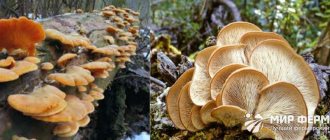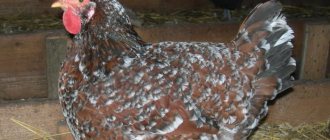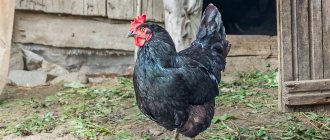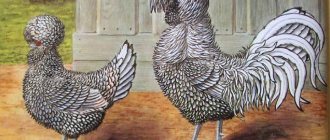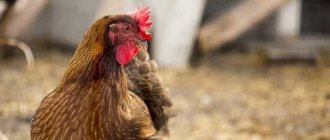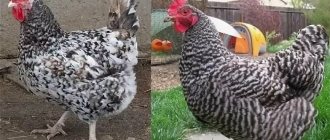History of the breed
The Pervomaisky chicken breed was created in Kharkov, even before the Great Patriotic War. The breed is already about 80 years old, but it does not lose popularity - its productivity characteristics are too high. The breed was bred on the basis of Yurlovsky vocal chickens and two American breeds - White Wyandotte and Rhode Island.
The formation of the breed began in 1935 and was completed in 1941. During the war years, the livestock was practically destroyed. Only a few dozen individuals remain. But our poultry farmers not only managed to restore the breed, but also increased its population so much that Pervomayskaya chickens spread throughout all poultry farms in the country.
Reviews
Judging by the reviews and videos that farmers shoot, you can understand that May Day chickens are an excellent addition to the poultry yard. The beauty of the bird itself and its productivity have long captivated its owners. First of all, it is worth noting that all poultry, from chick to adult, are resistant to diseases, therefore, almost all chickens survive. Chickens are excellent brood hens. The eggs are laid regularly and in a certain place, and they can calmly let a person pick up the eggs directly from under her.
This bird tolerates frost well, and with good feeding, egg production continues year-round. In their reviews and videos, farmers note that if in the cold season the quantity and quality of food is reduced, then egg production drops significantly, to the point that the chicken stops laying eggs altogether. Due to the fact that birds of this breed have a calm character and move little, they gain weight quite quickly and the poultry meat becomes tender.
Characteristics of the bird and standards of the Pervomayskaya breed
During selection, Pervomaisky chickens acquired external characteristics that they inherited from their “parental” breeds. These powerful and short-legged chickens look modest but impressive.
Color and plumage
The Colombian color is the main difference between the breed. With this color, the feathers of chickens are white, and there is a black edging on the neck. There are also dark feathers at the ends of the tail and flight feathers. Silver-white chickens with a fluffy white and black “collar” on the neck look strict, but elegant.
Color of Pervomaisky chickens:
- body – white;
- head – white;
- neck feathers are black, feather shafts are white;
- wings are white on the outside, with black feathers on the inside;
- the tail is black, black feathers often have a white edge.
The feathers of the “Pervomaytsev” are hard and densely spaced. Due to the increased density of feathers, these chickens are reliably protected from adverse natural influences - wind, cold, precipitation.
Torso
Both chickens and roosters of the Pervomaisk breed are quite large - they have a powerful body, strong physique and muscles. The chest is round in shape and protrudes forward. The legs are short compared to the body. The tail is small and slightly fluffy. Bones and muscles are well developed. The body is wide and slightly elongated. Small wings are tightly pressed to the sides.
Neck and head
The head of Pervomaisky chickens is small but wide, and the neck is short. Features and characteristic features of the head:
- The comb is rose-shaped. Ridges of this type are typical for frost-resistant breeds - they are less susceptible to frostbite.
- Earrings and earlobes are red, elongated, oval.
- The beak is black and yellow. The edges of the beak have a yellow edging.
Character
The main character trait of May Day chickens is calm behavior. This breed is not quarrelsome and pugnacious; these chickens are not afraid of people and easily get along with chickens of other breeds. They are distinguished by their agility and stubbornness only during the period of growth, when there is an excess of energy.
An overview of the Pervomaiskie chicken breed is presented in the video below:
Features of the character of chickens and roosters of the Pervomaisk breed:
- phlegmatic;
- stress-resistant;
- flexible;
- recognize the authority of the leader.
Puberty and egg production
This old, proven breed, unlike new crosses that produce eggs in the 4th month of life, matures much later. The first clutch appears around the 7th month. Maturing late, these chickens are characterized by long and high egg production.
A distinctive feature of the breed is the close connection between egg production and the quality and quantity of feed in the cold season. If you do not create good conditions for the chickens, they may stop laying eggs altogether. But as soon as the normal diet is restored, egg production returns to its previous level.
After 1.5-2 years, chickens experience a natural decrease in productivity. Therefore, it is during this period that young laying hens should be introduced into the poultry house.
When is the break in egg laying?
In the fall, in order not to artificially stimulate molting, poultry farmers gradually reduce the length of daylight hours. At the beginning of molting, laying hens' appearance deteriorates - they lose some of their feathers. Then a new feather grows in their place. During molting, laying stops. After 2-2.5 months, the masonry is restored and lasts all winter.
Peculiarities
Laying hens have not lost their instinct to hatch; they willingly sit on eggshells (it is also possible to use an incubator). Already at one day of age, first-time chicks can be distinguished by sex: hens have a darker yellow color than cockerels; this is clearly visible in the brood. Breeders report a low culling rate among chickens; They have good immunity, so they have good survival rate.
The young animals are gaining weight well; by five months they are already weighty carcasses. Oviposition begins at six to seven months. Chickens are characterized by good winter egg production, which is important for our harsh climatic conditions.
Productivity
The breed is highly productive in all respects:
- 98-100% of eggs are fertilized and are suitable for hatching healthy chickens.
- The average annual egg production of one hen is 160-200 eggs. The eggs are tasty, small (weigh about 58-60 g), the shell is brown.
- The weight of the chicken is 2.5-3 kg, the weight of the rooster is 3.8-4 kg.
Although chickens of this breed have a developed maternal instinct, there are no problems with the selection of eggs - a person can collect them without any problems. Laying hens lay eggs regularly, in one place, without trying to hide their eggs.
Full description of the breed
Pervomayskaya chicken looks different from others. Main parameters:
- head of medium size with a small curved crest;
- red earlobes;
- eye color - fiery;
- yellow beak;
- the frame is strong, with a wide chest;
- legs yellow, short;
- the tail is small, widened at the base, located at an angle of 20° in relation to the body;
- wings of medium length, close to the body, bluish-black in tone;
- body color is yellowish.
The main plumage is white, the tail and neck are tar-colored.
Price
You can order young animals and hatching eggs from VNITIP. The price for one day-old chick is 60 rubles, an egg is 35 rubles.
The cost may vary depending on the season. It is more profitable to buy in August or September.
One adult costs from 600 to 2000 rubles.
Character
Pervomayskaya chickens have a calm and peaceful character and get along well with young animals.
Roosters are not pugnacious or noisy. But if a threat arises, they are ready to defend their tribe. Therefore, it is better to keep them separately from other breeds.
Productivity
This breed has good meat and egg production.
Depending on the conditions of detention, hens begin to produce their first eggs at the age of 5-7 months. At the beginning of the clutch they reach a weight of 53-57 g, subsequent specimens are larger - 57-70 g. The shell is brown.
In winter, egg production rates decrease.
The quantity per year is 180-200 pcs. After 1.5-2 years, productivity decreases significantly. At this time, replacement young animals are released.
- The weight of roosters varies depending on age: at 3 months - 1-1.5 kg, at six months - 1.8-2.7 kg, per year - 3.2-3.5 kg.
- Mature chickens are smaller in size - 2.3-2.6 kg.
With a rationed and balanced diet, chickens rarely become overgrown with fat, so to obtain tasty meat they are fed ad libitum.
Advantages and disadvantages
Advantages of the Pervomaiskaya breed:
- high productivity;
- good health, disease resistance;
- resistance to cold;
- well developed maternal instinct;
- balanced disposition;
- high survival rate of chickens;
- good adaptive abilities;
- rapid weight gain with normal feeding.
There are almost no drawbacks to the First Mays, except that the young animals have a somewhat quarrelsome and timid disposition.
Maintenance and cultivation
Like all meat-and-egg type chickens, chickens have a good appetite . Feed consumption is compensated by egg production and rapid weight gain. With poor nutrition, chickens stop laying eggs; when the diet is restored, they quickly restore their ability to lay eggs. Pervomayki are inactive, which means their meat is not sinewy (the age of the bird also affects the toughness of the meat; the older the individual, the more sinewy its meat).
Birds tolerate cold well and acclimatize easily and quickly. Despite the fact that the Yurlovskie vulgars took part in the creation of the breed, May Day roosters are quite silent; their tone of voice is hoarse.
In general, chickens are distinguished by their friendly disposition and non-aggressive character . As the breeders of this bird in private farmsteads note, up to five months the young animals can be wild (they get scared at the sight of a person, when a person appears in the pen or in the chicken coop they rush in all directions), then they become calmer. Laying hens lay eggs in a disciplined manner and do not hide them; allow you to take eggs directly from under you.
The birds are characterized as medium-heavy. The cramped conditions in the chicken coop are tolerated patiently, but sometimes a struggle for a “place in the sun” may begin, and the weakest will be slaughtered. They respond well to walking.
Conditions of detention
Pervomaytsy are medium-heavy birds and can easily tolerate cramped conditions. But a struggle for territory is not ruled out. To achieve high egg production, it is necessary to provide the birds with good living conditions - a warm barn and a spacious run.
The Pervomayskaya breed is productive in any climate; it is bred throughout Russia - from the southern regions to the Far East.
Poultry house
A barn or poultry house for Pervomayskaya chickens is built from wood - beams, sleepers, and boards are suitable. Poultry house requirements:
- insulated building;
- the room is dry, warm, well ventilated;
- absence of drafts;
- the presence of a window - for the entry of sunlight;
- dry bedding on the floor - hay, straw, sawdust;
- in an unheated poultry house, the thickness of the litter in winter is up to 40 cm, then the temperature in the room will always be above zero;
- If poultry houses are not heated, a safe electric heater can be turned on.
The litter needs to be changed as it becomes dirty, otherwise the quality of egg production in chickens decreases.
Poultry house equipment
The barn in which the Pervomaisky chickens are kept is equipped with:
- Perches. They are made from beams or poles 40x40 mm. They are placed at a height of 60-100 cm from the floor. They are attached to the walls or supported on a beam of a similar cross-section.
- Feeders. They are made from boards, positioned at an angle - like the letter V. By nailing two beams at the bottom, you get legs. To prevent chickens from climbing into the feeder, a freely rotating pole is attached along the entire length - in the center. It is secured to metal pins, which are attached to beams nailed to the end boards. The pole prevents the chickens from getting into the feeder. Read about how to make your own chicken feeder here.
- Nests. They are made from plywood or boards. The dimensions of the “houses” are 30x30x25 cm. The width of the entrance to the nest is 20 cm. A small threshold is made at the entrance to prevent eggs from rolling out. The bottom of the nest is lined with straw. The nests are located at the same level as the perches.
You will also need a place for food and a table for preparing mash.
Walk
May Day residents are inactive, but in order to maintain high immunity, they need walks in the air. Moreover, they need to be allowed outside in the winter. For walking, an area is fenced off on the younger side of the barn. Given the mobility of chickens, the walk should be quite spacious. When determining its area, they are guided by the norm: for 1 bird - 2-3 square meters. m. Enclose the walking area with a metal mesh.
If the run is built separately from the chicken coop, it is necessary to make a canopy so that the birds can hide under it from the scorching sun and precipitation.
Keeping adult chickens
Comfortable conditions
To keep chickens of the Pervomayskaya breed, choose a spacious and bright room. Seal cracks to protect against drafts, install ventilation or install vents.
At low temperatures, hens stop laying eggs. Therefore, the indicators are maintained at the level of 11-15 °C; a decrease in heat to 4 °C is allowed.
Lay a thick layer of litter to absorb excess moisture. In winter, they make permanent bedding by adding a dry layer of sawdust on top.
Perches are installed at a height of 80 cm.
In winter, to preserve egg production, additional lighting is installed, increasing the daylight hours to 13 hours.
For every 4 laying hens you will need a nest fenced with a sheet of plywood. A wooden box lined with leaves or straw will do.
Laying hens need regular dust baths. It is recommended to install containers with coarse sand and ash in the chicken coop so that the birds clean their plumage and skin of parasites.
Walking yard
May Day chickens are distinguished by their phlegmatic character, but to maintain health it is necessary to arrange a walking yard. It is advisable to fence off the area near the poultry house by making a canopy from the sun's rays.
Walking helps to increase immunity and saturate the body with protein and green food.
Molting and break in egg laying
Chickens need molting to restore productivity, so in the fall the daylight hours are shortened to stimulate the change of plumage. An additional dose of vitamins is administered so that the livestock quickly acquires new feathers.
After two months, the hens restore egg production, regularly continuing to lay eggs during the winter. Productivity is maintained by additional lighting and the introduction of vitamin and mineral supplements into the feed.
Planned herd replacement
The maximum egg production rates in chickens of the Pervomaisk breed are observed two years after the laying of the first egg, then the rates decrease.
It is advisable not to confuse a decline in egg production with seasonal molting, so as not to cull a productive chicken.
By the time egg laying ends, care should be taken to renew the herd with young laying hens.
Prevention
Chickens of the Pervomaisk breed are distinguished by high immunity.
To avoid diseases, it is recommended to keep the premises clean, treat the walls with antiparasitic agents and do preventive vaccinations to keep the livestock healthy.
Drowsiness and ruffled feathers in young animals are considered a reason to contact a veterinarian in order to avoid infecting the livestock with infectious diseases.
Features of feeding
The Pervomayskaya breed is unpretentious in food - they eat everything they give. But if the diet is not carefully prepared, problems with health and egg production cannot be avoided.
Principles of feeding adult birds:
- The basis of the diet is whole grains.
- The daily grain norm is 40-50 g.
- In winter, the grain rate is slightly increased, in summer - reduced.
- The mash contains crushed grain.
- The mash is given in the morning or at lunch.
- Greens in summer are given 40-50 g per individual.
- In winter, instead of greens, give 10-15 g of dry concentrate.
- Every day - mineral supplements (bone and meat and bone meal, chalk - 3-4 g, salt - up to 1 g).
- During active baggage, the chalk allowance is increased.
- Periodically, chickens are given animal proteins. 3-4 times a week chickens are fed skim milk, broths, and meat waste.
- In winter, give 30-50 g of root vegetables per day.
- Use additives sparingly. Give up to 10 g of yeast, 3-4 drops of fish oil.
The diet of chickens of the Pervomaisk breed is influenced by the purpose for which they are raised - for eggs, meat or for reproduction.
To the tribe
Chickens raised for breeding are given 120-180 g of feed per individual, taking into account the season and nutritional value. Feeding Features:
- Be sure to feed vegetables;
- fatty and starchy foods are given in limited quantities - up to 20% of the total diet;
- access to greenery must be ensured.
For meat
Poultry fattened for meat is given a lot of feed and mash. They are fed protein products - fishmeal, meat waste, dairy products, vitamins and minerals. Young animals up to 1.5 months are fed with mixed feed.
Laying hens
Laying hens are given vitamins and feed is rationed. If chickens' metatarsals turn pale during laying, it means the birds need carotene. A premix with carotene, or foods containing this vitamin - pumpkin, carrots - are urgently introduced into the diet.
Caring for young animals
Nutrition
It is recommended to provide chickens of the Pervomaisk breed with adequate nutrition, which is given six times a day. As they grow older, the feed is distributed three times. Constant access to a drinking bowl with clean water is also necessary.
At first, the chickens are given a ground boiled egg with millet, adding vitamin supplements to the mixture. From the third day, the young animals are accustomed to chopped greens in order to reduce the cost of feeding the livestock in the future.
Gradually, wet mash, boiled root vegetables, and crushed grain crops are given out.
Containers with chalk are required to saturate the growing body of chickens with calcium. It is recommended to introduce small doses of bone meal and yeast.
Young animals are transferred to an adult diet upon reaching 1.5 months. Make sure there is a sufficient amount of protein components and mineral and vitamin supplements.
Room and temperature requirements
It is recommended to keep young animals under a hen that provides constant heating. Klusha accustoms chickens to food and protects them from attacks by birds of prey and animals.
When hatching chicks in an incubator, they are transferred to a box covered with woven material. Heating with infrared lamps will also be required.
In the first days of the young animals’ life, the temperature in the room is adjusted to 30 °C; when living together with a hen, it is 24 °C.
It is recommended to raise young animals in an insulated poultry house, having previously treated the walls and floor with disinfectants. Drafts and unsanitary conditions are the causes of disease and death of livestock.
Pedigree chickens with proper care are not affected by diseases, which makes it possible to achieve 100% survival rate of the population.
Reproduction
To create your first flock, it is recommended to purchase hatching eggs from poultry farms that breed purebred birds. The reproduction of the herd can be handled by brood hens, who willingly sit on eggs. You can also use an incubator.
Breeding options
There are several breeding methods:
- They buy hatching eggs from different poultry farms to create two unrelated families. Each family has two roosters - the main one and the spare one. From them young animals of the 1st generation are obtained. The males are killed and the young females are kept. Next year they will receive the 2nd generation. Further, family connections are undesirable and a replacement rooster is taken from another family. The pullets are mixed - 1/2 of their own and 1/2 of others. This option allows you to raise chickens up to 10 years old without buying birds.
- If you have a large house, you can form five chicken groups. From 4 groups of chickens, two lines are made, placing the roosters with neighbors. The 5th group is propagated without the intervention of strangers, and is used as a reserve.
- This method is convenient for those who do not have the opportunity to buy and incubate purebred eggs, but have access to purebred roosters. Outbred hens are crossed with the first purebred rooster. The offspring are crossed with the second rooster, the third generation - with the third rooster. As a result of such selection, almost purebred chickens are obtained.
Egg incubation
Incubation is a complex process in which the immunity of future chicks is influenced by the parameters in the chamber, the frequency of turning and ventilation.
Incubation includes the following stages:
- inspection and rejection of eggs;
- disinfection of selected eggs in potassium permanganate;
- laying eggs in the incubator;
- incubation;
- on day 20-21 – hatching.
We recommend that you familiarize yourself in more detail with all the nuances of incubating chicken eggs.
Chick selection
Hatched chicks are sorted according to signs of deformity. Approximately the same number of chickens are born with the necessary and unnecessary characteristics. If a farmer hopes to improve the breed, chickens must be selected strictly and repeatedly.
The first sorting is carried out immediately after hatching. The second – in 2-3 months. Individuals with:
- not pink combs that are too large or too red;
- white metatarsals.
The last culling is carried out after the first molt, when the bird's true color becomes visible. From the remaining hens, a dozen hens and a rooster are selected for breeding. It is impossible to take fewer females, since roosters are characterized by increased activity.
Chick care
Laying hens not only hatch chicks on their own, but also take excellent care of them - they protect them from birds, cats, bad weather, help them find food on the run, and keep them warm. If the chicks are under hen control, the house temperature is maintained between +22°C and +24°C. The chickens grow very quickly and by the end of the month they gain weight of about 1 kg.
It is important to provide care for day-old chicks. On the first day, they need a temperature of at least 33°C and a light on. The chickens are placed in a box, which is covered with a cloth and plastic bottles with hot water are placed inside. Holes are made in the box for ventilation.
Feeding
Principles of feeding chickens:
- In the first days, chickens are fed 5-6 times a day. After about 5 days, they are switched to 3-4 meals a day. They give boiled eggs, herbs, crushed eggs, and vitamins.
- On day 10, chickens are fed porridge, mash, dry grain mixtures, boiled vegetables, herbs and chalk.
- At 1.5 months, the chickens are completely transferred to an adult diet - they are given protein food, chalk, lime and shell rock. Once a week they give glucose with vitamin C.
Breeding
Basics
For breeding, birds are selected that meet the standard and are free from defects.
Chickens of the Pervomaisk breed have retained the brooding instinct, so they are suitable for owners who do not have free time to care for young animals. The bird sits on the eggs on its own and, after the chicks hatch, takes full care of them.
Hatching in an incubator or under a chicken of another breed is also possible.
To breed the breed, it is recommended to purchase incubation material or day-old young animals from poultry farms.
The fertilization rate of eggs reaches 98–100%, hatchability is about 100%.
Appearance of chickens
The description of the chickens repeats the characteristic feature of adult chickens - a thick body on short legs. Therefore, young animals are distinguished by their large dimensions compared to other breeds.
It is recommended to separate chickens by gender from the first days of life. Cockerels are covered with light yellow down, while hens are distinguished by a rich dark yellow shade of down.
Culling
Chickens of the Pervomayskaya breed show a high productivity coefficient if culling is carried out correctly. The process occurs in three stages.
Immediately after birth, weak young animals, as well as chickens with developmental defects, are discarded. Usually, such chickens die within the first two days, making the poultry farmer’s work easier.
The second culling is carried out with livestock at the age of three months. Young animals with a weak constitution, a leaf-shaped comb, and high or white metatarsals are subject to culling.
The last selection occurs during the juvenile molt, when deviations from the characteristic body color of the bird are visible.
For subsequent breeding, 10 hens with one rooster are suitable. One more is kept in reserve. Chickens should have a massive build with a developed chest, low legs and developed combs.
Health
The breed is generally disease resistant. What you should know about Mayday health:
- Infections attack them when hygiene in the poultry house and feeders is violated.
- Improper feeding, the predominance of dry food, often leads to blockage of the crop.
- Inbreeding should not be allowed - the offspring may turn out weak and unproductive.
- The rooster's voice may seem hoarse to inexperienced poultry farmers, but silence and quiet sounds are a feature of the Pervomaisk breed.
- Young and adult chickens may suffer from indigestion - it is treated with black tea or St. John's wort decoction.
Pervomayskaya breed of chickens - description, photos and videos
Author: Chicken Ryaba
/ Feb 28, 2021 at 12:52 pm
Hello, dear readers! Today we will look at a very interesting chicken, which is popular among farmers in the former Soviet Union. The Pervomayskaya breed of chickens is a very hardy and resilient breed that has gone through a lot of difficult stages in the history of its existence.
Today the population of this bird has grown, although quite recently it was on the verge of extinction. So, let's look at the information about it in more detail. Photos and videos are attached.
Planned herd replacement
The lifespan of Pervomaisky chickens is 10-12 years. Poultry farmers keep them for no more than 4 years - until the hens are able to lay eggs productively. Peak egg production occurs at 2 years. If chickens are kept for meat, then they are ready for slaughter at one year of age - that is when the meat is the most delicious, juicy and tender.
A hen can produce 2-3 broods per year, so replacing the herd with new stock is not difficult. All hatched chickens exactly replicate the parental characteristics.
Feeding May Day chickens
However, in order for the chicks to grow up healthy and strong, they need to be fed properly and provided with proper living conditions.
We will consider the rules of care and feeding below.
- It is very easy to create a menu for the first week of life, because it consists of a few products. The smallest chicks are given boiled eggs, greens, millet or other cereals (necessarily finely ground). Vitamin supplements, which are intended for “newborn” chicks, will also not be superfluous.
- In the future, you can give dry grain mixtures, nutritious porridges and mash with the addition of boiled vegetables. Without fear, you can introduce boiled carrots and potatoes into your diet. A large amount of greens will prevent vitamin deficiency, and chalk will replenish the need for calcium.
- Young animals are transferred completely to an adult diet closer to 1.5 months. They are fed food high in protein, not forgetting mineral and vitamin supplements.
- Diet in the first week of life: 6 meals. In the future, feedings are gradually made less frequent.
- In the room where the chickens live, drinkers with water are installed, access to which should be around the clock. Instead of water, it is useful to give black tea, but not strong tea - it normalizes digestion and prevents diarrhea. Glucose with vitamin C is also useful - it promotes the development of immunity and activity.
- The temperature for up to 10 days is 27-30 degrees, if the babies live alone. If the chicks are kept with a hen, 22-24 degrees is enough. Mother will warm them with her body heat if they suddenly freeze.
Breed analogues
There are breeds that coincide with Pervomaisky chickens in one or more characteristics. Similar breeds are in the table:
| Features and characteristics | Analogue breeds of Pervomaisky chickens |
| Egg production and carcass weight |
|
| Color and weight |
|
Distinctive features
Color
On farms, the meat and egg qualities of the breed are considered to be of primary importance, the exterior is in the background. Mayday chickens cannot compete with the remarkable representatives of the poultry yard, but they are distinguished by their interesting Colombian plumage.
The birds' body is covered with silvery feathers, there are dark areas on the tail, collar and wings. It is a mistake to confuse May Day laying hens with others of a similar color. To get your bearings, we recommend that you read the article “Adler Silver Chicken Breed.”
The Pervomayskaya breed is distinguished by thick plumage, which allows chickens to withstand winter temperature drops.
Weight
Chickens of the Pervomayskaya breed are prone to rapid weight gain, growing to market size within 6 months. In the first 3 months, the cockerels grow up to 1.5 kg, in 5 months - up to 2 kg, and by 5.5 months they already weigh 2.5 kg.
During fattening, cockerels almost do not develop a fat layer, which facilitates the work of creating a feeding regimen.
The weight of hens ranges from 2 to 2.5 kg, and that of roosters reaches up to 3.7 kg.
The livestock leads a quiet lifestyle, so when slaughtered they get soft meat with high taste. The meat of May Day chickens is valued on the market due to its soft texture and lack of hard fibers.
Body type
Pervomayskaya chickens have a developed muscular system. A characteristic feature is a massive, squat body with short legs.
Features of the structure of chickens:
- the body resembles a triangle;
- pronounced chest;
- developed dorsal region;
- voluminous belly;
- wings are medium in size;
- elongated neck with a small head;
- in laying hens the tail is located horizontally to the body, in cockerels - vertically;
- reddish lobes and face;
- the down-curved beak is yellowish in color.
The comb of chickens is almost invisible, while cockerels have a developed rose-shaped comb. This shape prevents frostbite, which is typical for breeds with leaf-shaped combs.
Vices
The following are considered deviations from the standard: dark feathers on the body, pale pinkish metatarsals, thin paws, a leaf-shaped comb, whitish lobes.
Unlike the Yurlovsky vocal breed, Pervomaisky cockerels make hoarse sounds, which is not considered a deviation from the standard.
Character
Thoroughbred May Day laying hens are distinguished by their peaceful nature and do not enter into conflicts with other inhabitants of the farmstead.
The young animals are frightened by sudden actions, but gradually get used to the owner. The livestock becomes calm as they grow older, so there are no problems when kept on open range.
The chickens obey the leader, who smooths out conflicts and ensures that order is maintained.
Laying hens and cockerels lack aggression, which is another advantage for breeding the breed.
Characteristics of chickens with similar qualities are given in the article “About the Poltava clay breed of chickens.”
Useful tips
Some useful tips for beginners:
- If you place together individuals that have the same plumage color as possible, there will be fewer conflicts. Birds that look the same have no desire to find out who is better.
- It is better to keep active and passive individuals separately. Those that are older and bolder will always take food from weaker chickens, and at the same time will peck them.
- If you pour a little less feed into the feeder than required, the laying hens will not scatter it.
- If a wet mash is prepared for chickens - with milk or other leaven, then give it as much as they will eat at a time. You have to throw away the half-eaten mash - it quickly turns sour.
External characteristics
During the selection process, the chicken acquired some external characteristics from its ancestors. The bird looks modest, but quite attractive. Let's consider the characteristics of her appearance.
- The plumage color is white. But, on the wings, in the mane and tail, there is a small black border. The appearance is a bit reminiscent of silver Adlers, although the beauty in question has nothing in common with this bird.
- The plumage is dense and rigid, thanks to which the birds are reliably protected from frost and cold.
- The weight indicators are impressive - for mature cockerels they range from 3.5-3.7 kg, and for hens - about 3 kg. Externally, roosters look much larger and taller than feathered ladies.
- Pervomayskaya breed of chickens with a triangular body - voluminous, but compact, and set low. The peculiarity is that the black-cloud has a wide but flat back, a voluminous, protruding chest and a round tummy. The wings are pressed tightly to the body and are small in size.
- The neck and head are small. The head is decorated with a red comb and earrings. In hens these decorations are of medium size, in roosters they are more developed. The skin of the face and earlobes are also reddish in color. The face is partially covered with fine stubble. Expressive eyes of red-orange color. The beak is curved at the end, colored gray-yellow to match the metatarsals.
Reviews from poultry farmers about the Pervomaiskaya chicken breed
★★★★★
Victoria P., Kemerovo region. I bought young Pervomaek animals, and at first I was upset - they were so naughty and timid.
And as they grew up, they became calm. Laying hens lay eggs regularly, the carcasses are attractive - they sell well at the market, the meat is truly tasty. Excellent breed, I want to breed in the future. ★★★★★
Roman G., Bryansk region. Our May Day chickens lay eggs on their own and reproduce on their own.
By the 5th month, young chickens weigh 2 kg. Excellent breed for meat and eggs. A small herd feeds the whole family, and we also take it to the market. Hide
Add your review
The old Soviet breed of chickens has successfully passed the test of time. Its popularity continues unabated due to its high productivity, endurance and good character. This breed will be useful in any farm or private household.
0
0
Copy link
Revival of the breed
After the registration of the standard in 1941, the war began, which led to the almost complete disappearance of the Pervomayskaya breed of chickens.
Enthusiasts decided to start restoring the population of May Day laying hens after the end of the occupation, so that the results of many years of breeding work would not be lost.
From the remaining livestock of 54 purebred chickens, the revival of productive poultry began. 20 years later, 56 thousand laying hens of the Pervomai breed were registered on the territory of the USSR.
They continue to be bred on private farms and on an industrial scale in Ukraine, Russia and Belarus.
Productivity indicators
Pervomayskaya chickens are excellent for breeding and growing on private farms. Since poultry is not particularly mobile, meat products have an extraordinary taste, which is in great demand on the market. Many novice poultry farmers are wondering what to do if chickens eat their eggs as soon as they are laid? In this case, shell rock and chalk must be included in the feeding ration, since the bird does not have enough calcium in the body.
In addition, these birds are distinguished by high rates of annual egg production, which allows them to profit from the sale of eggs. Each year, one laying hen brings its owner about 140-180 brown eggs. The weight of 1 testicle is about 60 grams. Thus, if the question arises, how many eggs does a laying hen of the Pervomaisk breed lay per day, the answer is located just above the text.
The meat of these birds is characterized by excellent taste, tenderness, lack of veins, and white color. True, the older the individual, the more vitality of its meat products increases. According to the standard, these birds belong to the meat and egg category.
Summing up the results of this article, we can conclude that the Pervomaiskaya chicken breed is an almost ideal option for breeding and rearing by a novice poultry farmer. The above text answered the question of why chickens do not lay eggs and what to do in such a situation, described the diet, as well as living conditions and care.
The described breed of poultry enjoys well-deserved popularity among poultry farmers all over the world due to its extraordinary endurance, unpretentiousness, and resistance to a variety of diseases. In addition, since poultry is meat and egg oriented, its productivity indicators are at the highest level.
https://youtube.com/watch?v=VU4dAnnf9ag
Owner reviews
Reviews from owners of such birds are very good. Chickens get sick infrequently, do not require special care, and their egg production is high. A big plus is their frost resistance. If the chicken is well fed, then it will lay eggs beautifully. Chickens of this breed are resistant to various diseases and grow quickly.
It is profitable to keep such an unpretentious but productive bird. She will eat meat and lay eggs well. To maintain this ability in the winter, you need to properly insulate the chicken coop and provide additional lighting. Chickens lay good, large eggs, which contributes to their excellent sales.
Some indicate that this breed consumes more feed. However, their high productivity fully pays for this.
Analogs
Of course, each breed of chicken has its own unique characteristics, which is why poultry farmers value them. Chickens of the Pervomayskaya breed can be compared in terms of egg production and carcass weight with other breeds of meat and egg type: Kuchinskaya Yubileiny (the same weight, the egg production is slightly higher) and the Leningradskaya White (a little larger, the egg production is slightly higher).
In color and weight, chickens of the Adler silver breed and Sussex chickens of Columbian color are similar to Pervomaek. The Poltava clay breed of chickens, in addition to the functional characteristics (weight is slightly less, egg production is similar, the color of the egg shells is also light brown) is similar to the Pervomaikas in the same friendly disposition.
If only you knew what characteristics the Master Gray chicken has! You will be surprised.
To properly waterproof basement walls, you need to know how to do it. You can find detailed instructions here.
Chickens of the Pervomaiskaya breed, due to their unpretentiousness, can become ideal birds for breeding for novice poultry farmers. Experienced poultry farmers value them for their beauty and practicality. In general, they are ideal for breeding in private backyards.
If you find an error, please select a piece of text and press Ctrl+Enter.
Content
Pervomayskaya chickens are characterized by a fairly high unpretentiousness, as well as an incredible ability to adapt to almost any climatic conditions. Even if you keep birds in an uninsulated poultry house in winter, the main population of birds will remain intact. Many poultry farmers are interested in how long laying hens live at home with proper care.
If the basic requirements for caring for Pervomaisky chickens are met, they can live for about 6-8 years, provided they are provided with adequate food. These birds, like other domestic chickens, are kept in a chicken coop equipped with nests and perches. If you purchase chickens of this breed on the market, it is not difficult to distinguish the gender, since the females have a rather dark plumage color than the cockerels.
Not every poultry farmer knows when and how chickens of this species lay eggs. Most often, birds begin to lay eggs when they reach 7 months of age; in addition, in winter they practically do not reduce their egg production. Thanks to such indicators, reviews from poultry farmers about this breed are mostly positive. All individuals of this species are characterized by the presence of excellent immunity; for this reason, there is practically no culling of the livestock.
Young females and males gain body weight very quickly. When they reach puberty, they may show fear of humans, although over time they become sedentary and calmer. Every experienced poultry farmer knows how chickens endure winter in the harsh regions of Russia. Laying hens part with their eggs very easily and do not hide them at all. Inside the poultry house, chickens often start fights, crushing the weak and taking the best places.
Caring for May Day chickens
Initially, you need to take care of the poultry house and free-range space. When chickens of this species lose feathers, they are most likely simply molting, since they are resistant to disease.
When installing a chicken coop, you need to ensure that the entire structure is protected from the appearance of various rodents. Feeders and drinkers are installed inside the poultry house, as well as a bath with a mixture of sand and ash. The floors are covered with straw or hay, and the outside is insulated, especially if you live in harsh regions of Russia. When hens of this breed cluck, it means the hen has laid eggs and you can pick up the egg.
According to reviews from breeders, these birds can be released for free range even in winter, albeit in a pre-equipped area. This run is located on the south side of the chicken coop. These birds are distinguished by some mobility, for this reason the area for walking should be large. Such a place is fenced with a simple chain-link mesh.
Feeding the May Day birds
It should be remembered that the diet of laying hens at home for this type should consist of high-quality feed. If this condition is not met, the chickens will sharply reduce their egg production. When the previous quality of the diet is restored, egg production will be restored. The menu for birds of this breed is fairly standard and consists of grains, herbs, vegetables, as well as vitamin and mineral supplements.
In order for birds to produce as many eggs as possible, the diet of laying hens must be balanced and of high quality. The main menu should consist of wet mess, which is made from scraps left over from the table. At the same time, we must not forget that such food quickly becomes unusable, for this reason it must be placed in small portions in the feeders. Vitamin supplements can consist of various greens and vegetables from your own garden.
If there are no such products, then you should purchase special industrial feed. You can also include Zdravur Layer, which is very popular among poultry farmers, in the standard diet. Young animals need to be fed about 3-4 times a day.
The ideal diet for laying hens is as follows:
- 30 gr. damp bumpiness;
- 120 gr. dry feed;
- 100 gr. boiled potatoes;
- 0.5 gr. salt;
- 7 gr. cake;
- 2 gr. bone meal;
- 3 gr. chalk;
- 1 gr. yeast.
Thanks to this list, a novice poultry farmer will know how much a laying hen eats on May Day. True, the diet may vary somewhat, depending on the time of year. In late spring, summer and early autumn, birds receive vitamins in the form of fresh grass, as well as other products obtained during free range. In winter, the lack of vitamins is replenished with the help of fresh or cooked vegetables.
Breeding and keeping Pervomaisky chickens
Chickens have not lost their parental instinct and independently cope with the role of hens. They eagerly sit on eggs and carefully protect the babies. This allows you to save on the purchase of an incubator. Chickens are characterized by high vitality, rarely get sick, are very mobile, and quickly gain weight.
The Pervomayskaya breed of chickens has an average early maturity and individuals begin to lay eggs at approximately 6 months of age. However, already at 4-5 months they have a good weight and can go for sale. The average weight of an adult rooster is about 4 kg, and a chicken – up to 3.5 kg. May Day laying hens are capable of laying up to 200 large brown eggs of various shades during the egg-laying period. The weight of one egg is about 60 grams. According to farmers, chickens maintain high egg production even during winter cold.
Almost every poultry farmer strives to buy May Day chickens. Individuals differ in that they always have a very good appetite. Feed is consumed quickly, but at the same time the farmer receives a sufficient number of large and nutritious eggs, as well as tender chicken. The meat of Pervomaisky chickens literally melts in your mouth.
Keeping chickens of this breed is not problematic, they are calm, not picky, and not noisy. They get along well in a chicken coop with birds of other breeds. They can easily withstand winter cold, so there is no need to additionally heat the chicken coop.
The diet of chickens of the Pervomaisk breed can consist of dry and wet mash, mixed feed, both factory-produced and home-produced. To saturate the chickens' body with vitamins and microelements, you can use grated vegetables, herbs and nutritional supplements for chickens, which are sold at the pharmacy.

